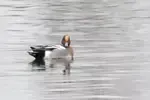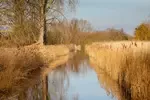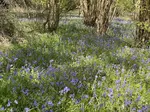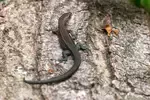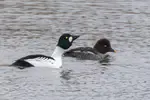- Home
- Cambridgeshire walks
- Winter Sunrise
Short-Eared Owls and a Winter Sunrise, Nene Washes
A 5:30 AM alarm, on a frosty Sunday, is a special kind of cruelty.
As it sliced through the quiet dark, every sensible part of my brain screamed "no." But another voice, the one hopelessly addicted to the promise of golden light and wild things, whispered about the Short-eared Owls of the Nene Washes.
That was the voice I listened to.
This isn’t just a guide to a place; it's an exploration of the feelings that make a frozen morning unforgettable.
It’s about the themes that emerge when you stand and watch a landscape wake up: the raw beauty of the light, the lethal grace of the hunters, and the constant, reassuring presence of the travellers who call this place their winter home.
Come with me. I’ll share the moments that made the cold worthwhile.
A World of Frost and Fire
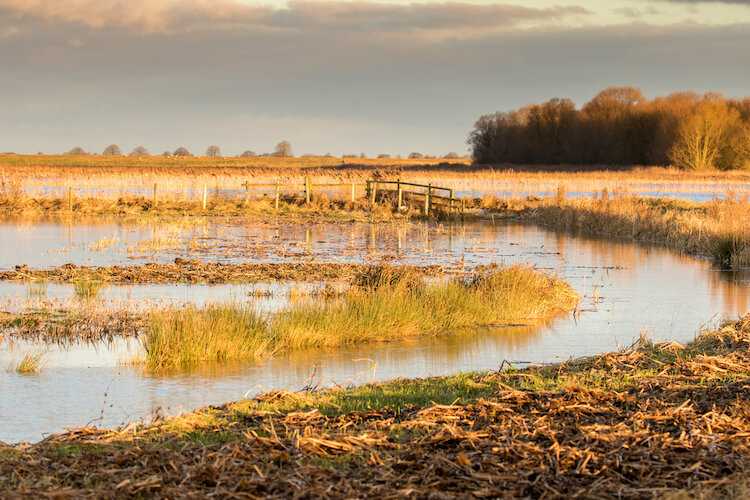 The breathtaking view that made the 5:30 AM start completely worthwhile!
The breathtaking view that made the 5:30 AM start completely worthwhile!The forty-five-minute drive through the narrow, icy Cambridgeshire lanes felt like a pilgrimage in the dark.
Then, as we crested a small humpback bridge, we saw it.
The horizon was bleeding pink and orange, a sight that made the ridiculously early start feel like a stroke of genius.
The vast, flat expanse of the washes, dusted in a layer of frost, unfolded beneath a sky that was slowly catching fire.
The air was so sharp it felt clean and the silence wasn't empty; it was full of anticipation.
This is the "Golden Hour" photographers worship, but no technical term can truly capture the feeling of standing there, watching the world awaken in such breathtaking colour.
As I raised my camera, my screen lit up with the scene, but I knew it was lying to me.
A little voice in my head, born from a graveyard of past failures, started chanting, 'The foreground will be black. Trust the histogram, not the screen.'
It’s a boring-looking graph, but it's the only honest broker when you’re trying to capture the shadowed reeds and the brilliant sky without sacrificing one for the other.
The only sound was the satisfying crunch of frost under my boots, a rhythm that settled my mind and made the frozen fingers entirely worth it.
The Hunters
As a self-confessed raptor fanatic, the Short-eared Owls were the main draw. Still, I never dared to hope it would be so easy. Mere minutes after we arrived a hunter appeared. A pale, moth-like shape materialised, quartering low over the reeds. Its flight was buoyant, almost weightless.
My reaction was pure fumble. My heart was thumping, my numb fingers felt like clumsy sausages on the small buttons.
As the owl circled back, the calmer voice in my head took over: 'Breathe. Anticipate the flight path. And for heaven's sake, check your shutter speed!'
I managed to crank the dial to 1/1600s, thinking, 'That has to be fast enough to freeze the wings. Now, just keep it in the frame.'
The viewing bank was a long way from the action, and I remember a wave of relief washing over me. 'Thank goodness I remembered the teleconverter.' That little tube of glass that gives my lens extra reach was invaluable.
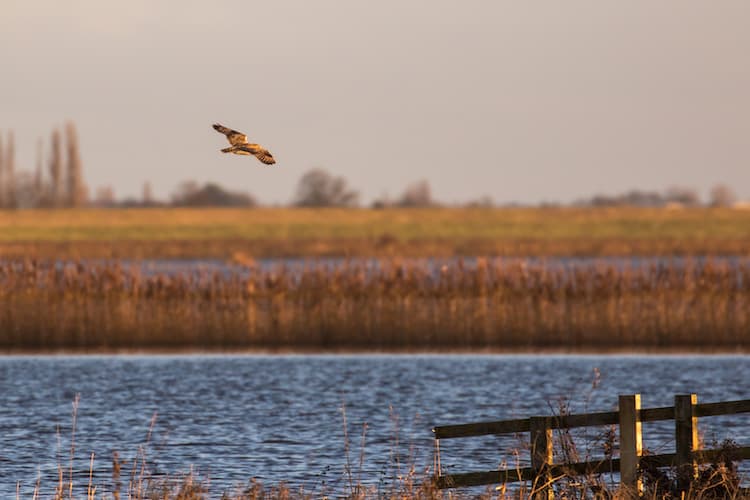 My first sighting – proof that excitement and numb fingers are a terrible combination for photography, but what a moment!
My first sighting – proof that excitement and numb fingers are a terrible combination for photography, but what a moment!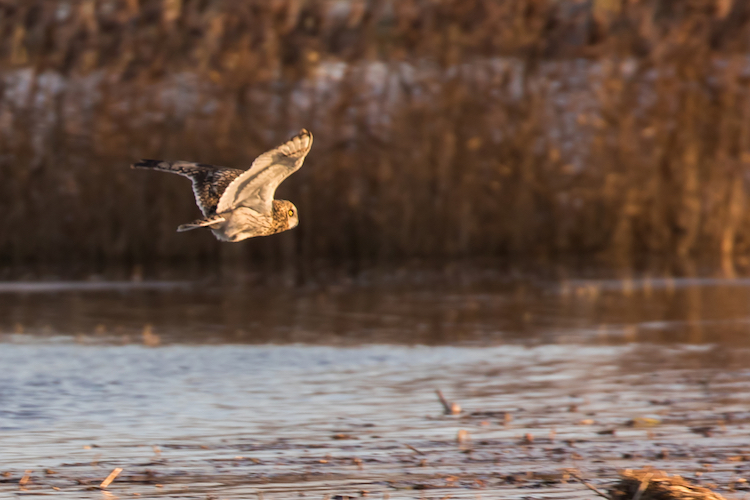 A teleconverter lens attachment was essential for getting the owl larger in the frame from the distant viewing bank
A teleconverter lens attachment was essential for getting the owl larger in the frame from the distant viewing bank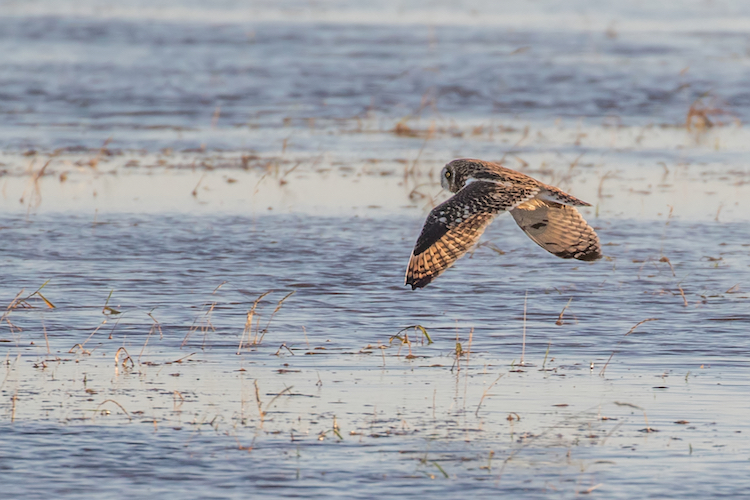 Quartering low over the water – a classic hunting technique for Short-eared Owls searching for voles near the banks.
Quartering low over the water – a classic hunting technique for Short-eared Owls searching for voles near the banks.Later, a different hunter put on a show: a female Kestrel, performing her signature 'wind-hovering' act.
As she hung motionless, I could feel my camera’s continuous autofocus working overtime.
I remember thinking, 'Stay with the eye, stay with the eye,' silently begging the little green square in my viewfinder not to jump to the more contrasty wingtip.
Suddenly, a feisty Black-headed Gull launched itself at her, a frantic explosion of aerial drama. It’s in these unscripted, chaotic moments that your trust in your autofocus is truly tested.
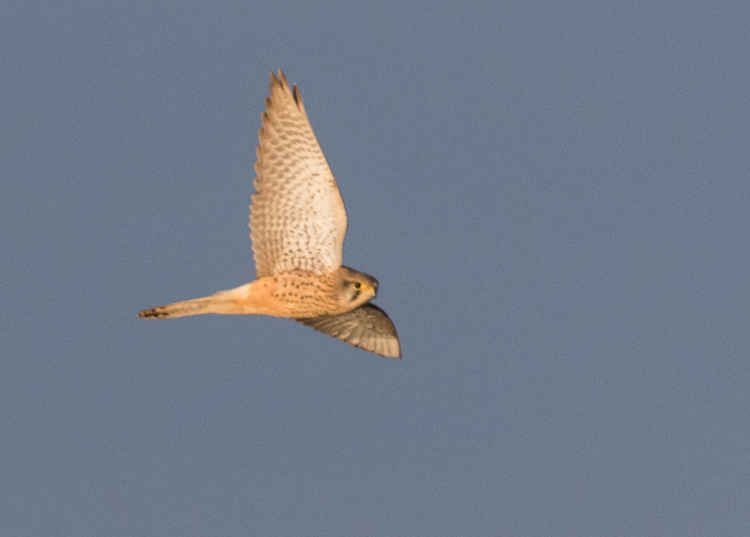 A female Kestrel demonstrates its signature 'windhovering' technique, scanning the Nene Washes margins for voles or mice.
A female Kestrel demonstrates its signature 'windhovering' technique, scanning the Nene Washes margins for voles or mice.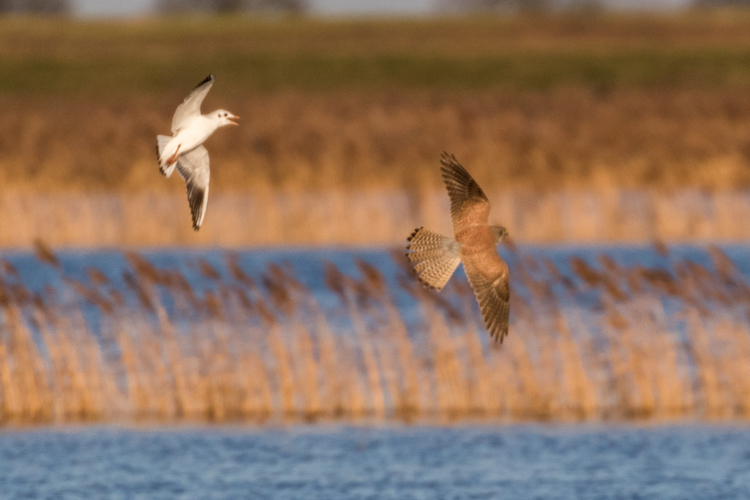 Capturing fast aerial interactions like this requires quick reflexes and continuous autofocus.
Capturing fast aerial interactions like this requires quick reflexes and continuous autofocus.The final raptor was a Marsh Harrier, soaring low over distant reeds.
t was a reminder that sometimes the best tool isn't a camera, but a pair of binoculars and the decision to just enjoy the moment for what it is.
The Winter Visitors
While the hunters patrolled the skies, a calmer scene unfolded on the water.
A family group of Whooper Swans drifted serenely, their brilliant white feathers luminous against the dark water - elegant travellers from the north. The sky was also a constant conveyor belt of ducks: Wigeon, Teal, Shoveler, and my first-ever Pintails.
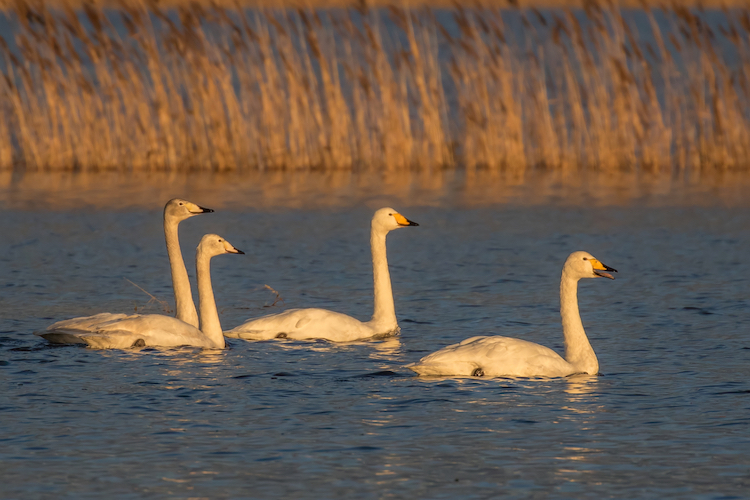 This family group included several young cygnets, identifiable by the lack of bright yellow on the beak.
This family group included several young cygnets, identifiable by the lack of bright yellow on the beak.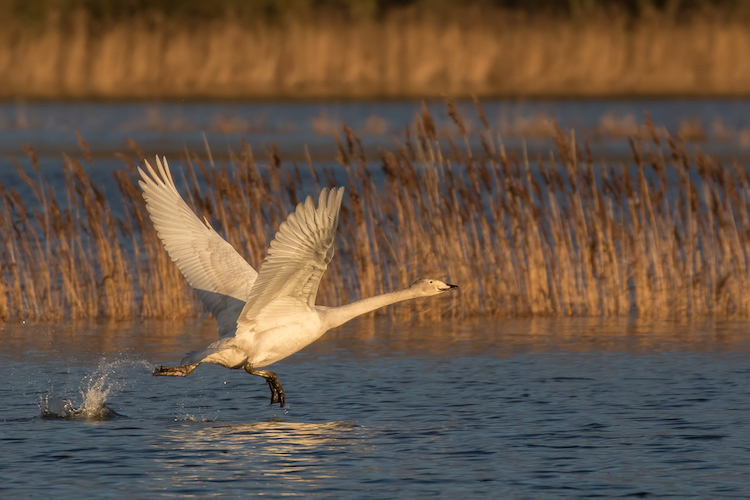 A young Whooper Swan gathers speed for takeoff across the water surface.
A young Whooper Swan gathers speed for takeoff across the water surface.There's a beautiful challenge to capturing fast-flying ducks.
If juggling all three settings at once feels like a circus act, you're not alone.
My starting point is almost always Shutter Priority mode. I set it to at least 1/1600s and find myself thinking, 'Okay, you handle the light, I'll handle the speed.'
It’s a partnership with the camera. I used to be terrified of the high ISO the camera would choose, hating the grainy look. But I’ve learned to see it as character. A gritty photo from the half-light feels more honest than a perfectly clean image.
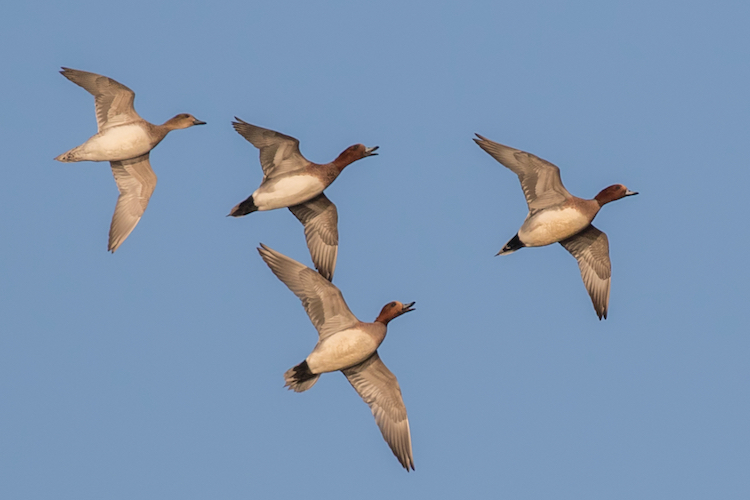 The distinctive whistling calls of Wigeon flocks were often heard overhead during the morning walk.
The distinctive whistling calls of Wigeon flocks were often heard overhead during the morning walk.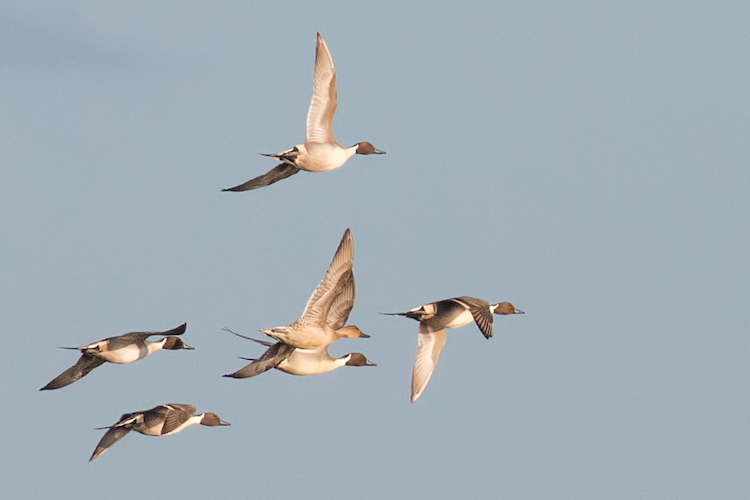 A welcome sight – my first time photographing Pintails at the Nene Washes, as mentioned in the text!
A welcome sight – my first time photographing Pintails at the Nene Washes, as mentioned in the text!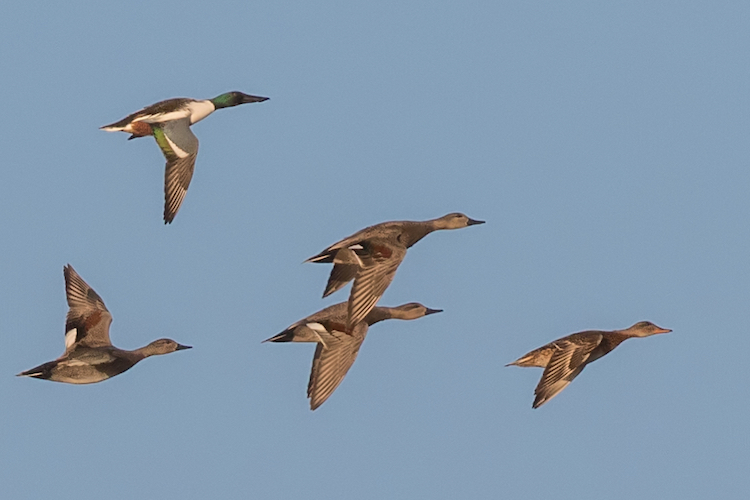 Using a fast shutter speed is necessary to freezing the wing beats of different duck species in flight.
Using a fast shutter speed is necessary to freezing the wing beats of different duck species in flight.The air also filled with the chattering calls of Fieldfares, a true sound of the season.
I love seeing their distinctive grey heads and speckled chests, a splash of Scandinavian colour against the stark winter landscape.
Photographing a whole flock is a different game; the camera's autofocus, which works so hard on a single bird, can get completely overwhelmed.
In those moments, I've learned to stop trying for a perfect portrait and instead think, 'The story here is the chaos. Narrow the aperture to f/11 and capture the pattern.'
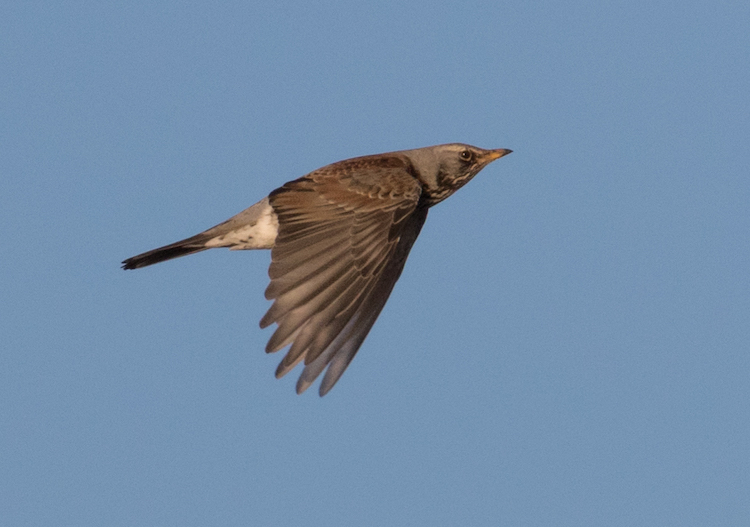 This image shows the Fieldfare's rusty back tone - characteristic of these winter visitors
This image shows the Fieldfare's rusty back tone - characteristic of these winter visitors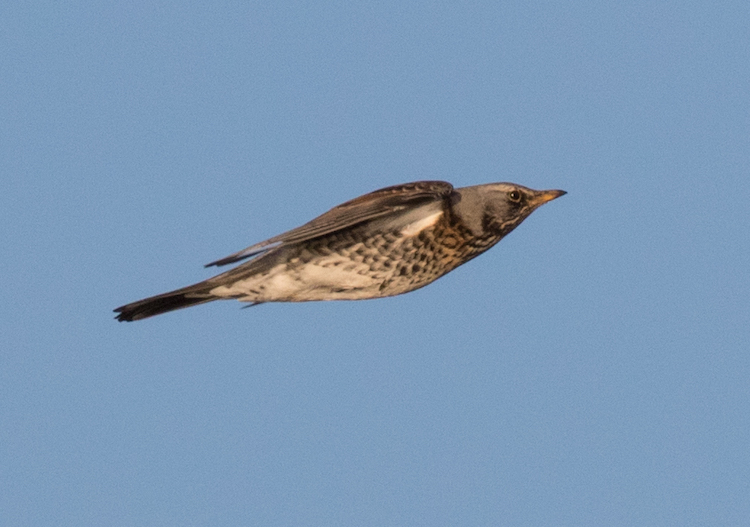 A Fieldfare, recognisable by its grey head and speckled chest.
A Fieldfare, recognisable by its grey head and speckled chest.A Poignant Acrobat
Amid the chaos, a flash of iridescent green revealed a flock of Lapwings.
Seeing them always brings a lump to my throat. Forty years ago, these "Green Plovers" were a common sight in the fields around my home.
Now, with their numbers in steep decline, each sighting feels like a precious, poignant gift, a fleeting dance from a world that’s quietly fading.
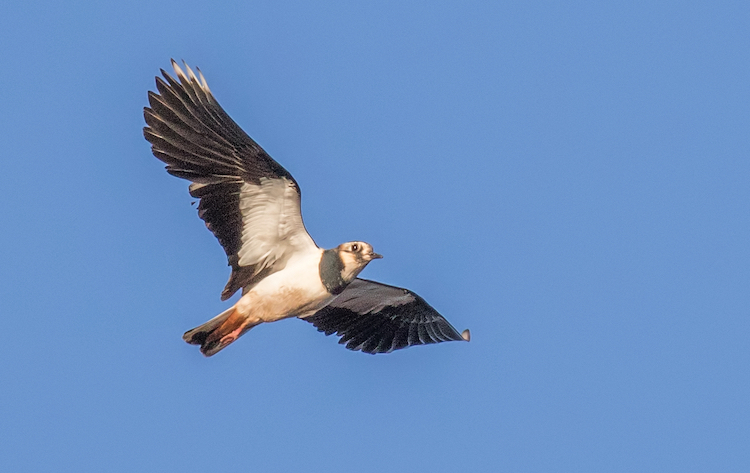 The beautiful 'Green Plover' – sadly now Red Listed in the UK due to significant population declines.
The beautiful 'Green Plover' – sadly now Red Listed in the UK due to significant population declines.A Fleeting Encounter
Just as things were settling, movement on the bank caught my eye: a handsome Roe Deer buck and two does bounding across the frosty ground.
Their russet coats were perfect camouflage, and my camera’s autofocus immediately started hunting, confused.
This is where muscle memory takes over.
With a sigh, I switched to manual focus, my thumb instinctively finding the button.
'Pre-focus on that patch of reeds they're heading for,' I thought, cranking the shutter speed to freeze their powerful leaps. It was a frantic, split-second combination of technical adjustment and hopeful guesswork that paid off.
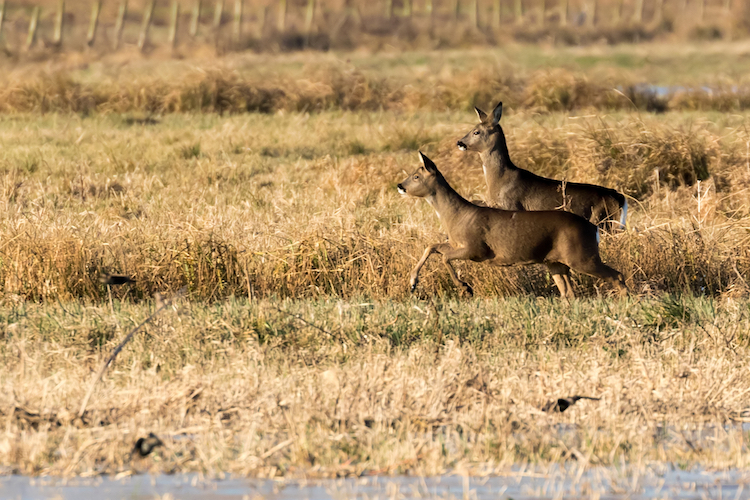 Their camouflage made autofocus tricky; manual focus and a fast shutter speed (1/1600s) were needed!
Their camouflage made autofocus tricky; manual focus and a fast shutter speed (1/1600s) were needed!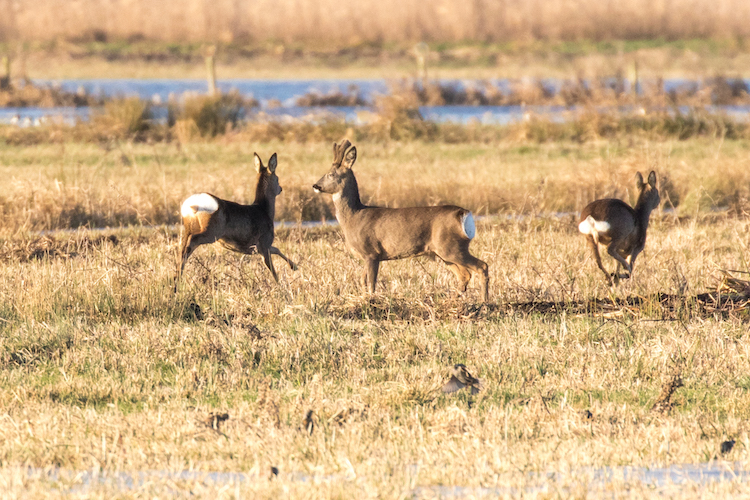 The handsome buck bringing up the rear, keeping watch as the does ran ahead.
The handsome buck bringing up the rear, keeping watch as the does ran ahead.By mid-morning, we were thoroughly chilled but buzzing.
That winter sunrise was a morning of quiet magic, of ghostly owls and fleeting deer.
It was a powerful reminder: sometimes, the greatest rewards are found on the other side of a ridiculously early alarm.
But the story of the Nene Washes has other, louder chapters.
The reserve is now home to a true giant—the bugling, magnificent Common Crane. Seeing them here for the first time was an adventure of a totally different scale, and I can't wait to tell you about it on the next page.
Visiting RSPB Nene Washes
📍 Key Access / Viewing: Main access for viewing is typically via the Eldernell area. From the car park (see below), follow the public footpath along the adjacent flood embankment/Counter Drain for extensive views over the Washes. Note: There is generally no public access directly onto the reserve fields from this area.
🌐 RSPB Website: Visit the official RSPB Nene Washes reserve page.
(Check here for the latest sightings, detailed access maps, potential flooding conditions/closures, and events.
⏰ Best Times / Seasons: Winter (Nov-Feb) is prime time for large wildfowl flocks, Whooper Swans, and Short-eared Owls (often best viewed late afternoon). Common Cranes are increasingly seen, particularly autumn/winter. Spring/summer brings breeding waders and marsh harriers.
❗ Facilities & Terrain: Be prepared! Main viewing areas like Eldernell typically have very limited facilities (no visitor centre, cafe, or toilets usually on site). Access involves walking on public footpaths along river banks, which can be uneven, exposed, and very muddy, especially after rain or floods. Appropriate sturdy footwear is essential.
🅿️ Parking: Small car park located at Eldernell. To reach it, turn north off the A605 (east of Whittlesey, near the prominent John Deere depot) and follow the single track road for approximately 1 mile. Be aware: No vehicular access is permitted beyond this car park.
👀 Viewing Notes: Viewing is typically from exposed banks or public footpaths. Dedicated bird hides are not a feature of the main Washes areas easily accessible by car. Binoculars or a spotting scope are highly recommended due to the distances often involved.
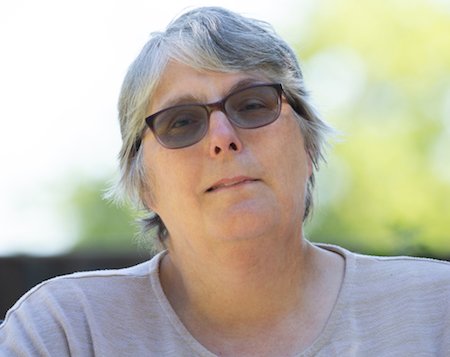
About the Author
I’m a wildlife photographer who learns on everyday walks. This site is my field notebook: practical photo tips, gentle ID help, and walk ideas to help you see more—wherever you are.
Step Behind the Wild Lens
Seasonal field notes from my wildlife walks: recent encounters, the story behind favourite photos, and simple, practical tips you can use on your next outing.
